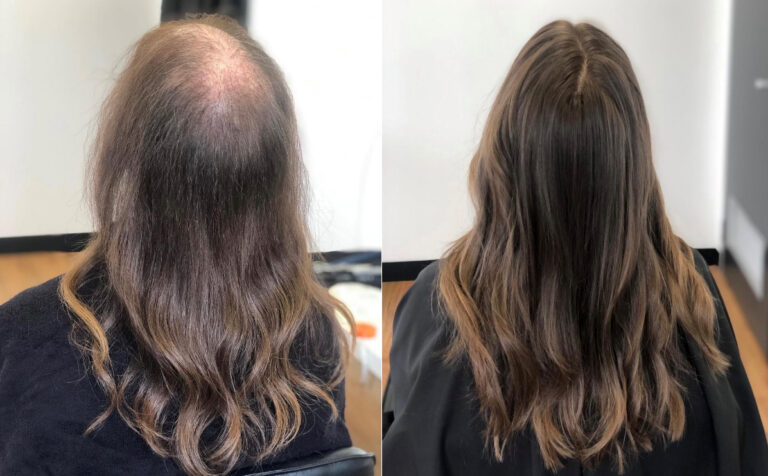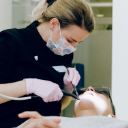
There have been many theories as to why hair loss in women has increased, but it seems one predominant factor is stress.
In the modern career world, women are now gender equals. Juggling professional and personal responsibilities means they now fall prey to what were once traditional male illnesses like; heart disease, stomach ulcers and high blood pressure that are often triggered by stress. Hair loss comes under that umbrella.
It is known that chronic or acute stress has the effect of lowering the production of oestrogens. Testosterone levels may not increase as a result but it is a powerful hormone. It often becomes more active affecting genetically targeted hair follicles which, had they been functioning properly, would have been previously protected by higher oestrogenic hormone levels.
It’s estimated that one in four women are affected by female pattern hair loss. Whether it will affect you, all depends on whether both your parents carry the dominant hair loss gene. Fortunately, women have higher levels of Oestrogens, so if only one of your parents carries the gene then – unlike with Male Pattern Baldness – it’s unlikely to ever activate as it would in men.
This type of hair loss spreads more slowly in women than men. The hair on the top and front of the scalp gradually becomes finer and weaker, and the shaft diameter is reduced.
In more advanced or severe cases, the crown area and the hair growing above the ears are also affected. When this happens, levels of the male hormone testosterone are raised, which may cause other symptoms like; oily skin, acne and Hirsuitism – a masculine pattern of excessive hair growth on the face and body. Menstrual disturbances and lowered fertility might also accompany this problem.
Instead of producing Oestrogen the ovaries malfunction causing the metabolism of testosterone to take place. Hair loss is one of the major symptoms, which also includes; stopping of periods, weight gain, infertility, oily skin, acne and hair growth on the face and body (hirsuitism).
Hormone therapy and minor surgery are usually successful in solving all the problems which may occur.
The adrenal gland produces the hormone adrenaline, which acts as a stimulant. When a tumour appears on the gland, it can cause a conversion of the hormones produced which disturbs their chemical production and forms testosterone. The effects are similar to Polycystic Ovary Syndrome.
With severe hair loss problems, a thorough medical diagnosis is essential to find the cause or site of the excessive production of testosterone before treatment is given.
Fortunately in most cases the results are very good but may take time to achieve. Treatments by Trichologists are always recommended following medical check-up to ensure re-growth of hair.
During early pregnancy oestrogenic hormone levels increase. This causes the normal cycle of hair growth to slow down, resulting in only about five per cent of the usual hair fall and replacement to occur. Hairs – sometimes including those on the eyelashes and eyebrows – which would have usually stopped growing, continue to grow beyond their normal life cycle, whilst new ones keep appearing. This is why most pregnant women’s hair seems so much thicker as more hairs are in active growth than usual.
As long as the expectant mother is in good health, this abundance of hair continues to flourish until the baby is born. However, as soon as she has given birth, a woman’s hormone levels change very rapidly. And all those excess hairs, which were growing beyond their normal lifespan, revert to telogen hairs and begin to fall out. This can start one month post-birth, but usually occurs after three. Occasionally, a speeded-up version of the process causes hair to fall out by the handful, distressing the exhausted mother.
Usually, the excess hair falls over a period of a month or two and gradually decreases. In some cases, particularly when breastfeeding, the milk producing hormone prolactin can delay hair loss.
The important thing to know and remember is that as fast as the old hairs are being shed, new anogen hairs are growing, so that at scalp level the number of hairs rarely decreases. There will, however, be a large number of short new hairs growing, and less long hair.
Under normal circumstances the hair is all growing back by the time the baby is a year old. But approximately one in a thousand women find that their hair does not grow back after childbirth and this is usually due to specific health problems or stress, poor circulation and anaemia (lack of iron).
All problems are usually easy to correct and treatment is highly successful.
These may cause slight hair changes as described for childbirth. Hair loss is more noticeable if miscarriage or termination occurs, following the first three months of pregnancy.
Immediate regular treatment will help to stop hair loss and speed complete recovery of hair growth.
Apart from some increased oiliness, actually being on the Pill doesn’t usually interfere with hair growth. Any reactions that do occur are temporary, and more likely to happen during starting and stopping. For the first three months of taking the contraceptive, some women find their hair falls out at a slightly increased rate, whilst the more fortunate find theirs grows thicker.
Stopping the Pill sometimes causes the same reaction as that occurring after normal childbirth, although usually in a mild form. Hair shedding will increase slightly about three months after discontinuation, as a new growth cycle of hair begins.
Regular treatment will help to establish new growth cycle more rapidly.
Very rarely contraceptives with a high level of Progestins may cause diffuse hair loss together with acne and an increase in body hair. If these symptoms occur AFTER starting to take the pill, a change to a pill based on ethinoestradiol may be needed. Although rare, it is sensible to be aware of any gradual changes.
Following a change of pill, treatment will work rapidly.
Low blood pressure, poor circulation, lack of iron and low ferritin levels which produce haemoglobin – the oxygen carrying component of blood – can frequently cause diffuse hair thinning from all parts of the scalp. The hair may become lighter and some of them will be finer in texture. The hair often becomes more brittle and strands break off in different lengths.
A blood test followed by iron supplements in the diet will normally solve the problem within a couple of months. If the scalp circulation is very poor or the scalp muscles too tense, regular manipulative and vibratory massage of the scalp will aid re-growth of hair. Hair changes at the menopause Gradual thinning and finer textured hair are common signs of advancing age in women. For most, general good health, fitness, diet and maintaining a good scalp circulation are effective in slowing down the process.
However, for those genetically at risk, or with a previous hair thinning problems, this is a time in life when the loss of hair may really become visible and noticeable.
HRT has been shown to be highly effective in maintaining or improving hair growth in middle-aged women. It must be recommended and prescribed by a Doctor as it does have some adverse side effects in a few women.
Women’s hair loss – contact us now for a free initial consultation
Practice
© COPYRIGHT 2004-2023 LONDON CENTRE OF TRICHOLOGY. ALL RIGHTS RESERVED





